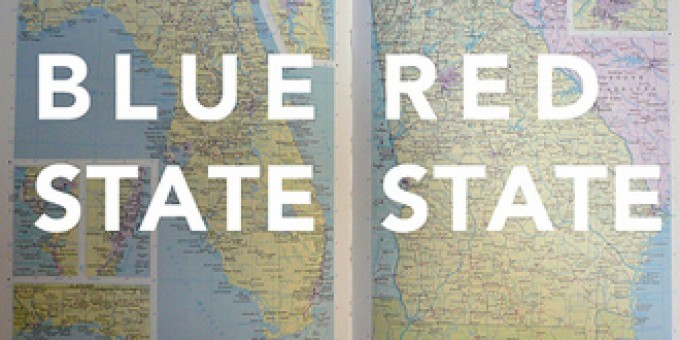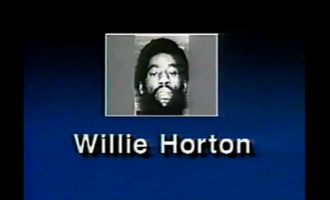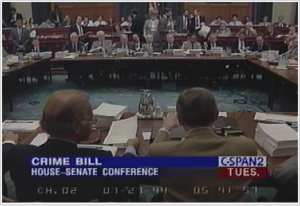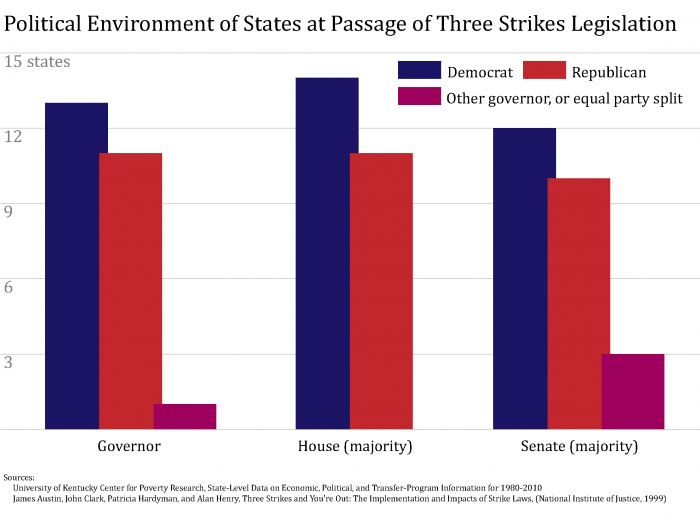
On December 15, 2010, a group of conservative politicians and activists officially launched the “Right on Crime” initiative, creating a stir among criminal justice reporters, reformers, and scholars. Luminaries of the right—including anti-tax crusader Grover Norquist, notoriously “tough on crime” former Speaker of the House Newt Gingrich, and former “Drug Czar,” radio host, and champion of the war on crime William Bennett—signed a pledge to reform criminal justice. Among other things, the conservatives called for limiting “overcriminalization,” expanding drug courts, decreasing mandatory minimum sentences for nonviolent offenders, and increasing alternatives to imprisonment.
Right on Crime argued that runaway penal expansion violated the conservative principles of small government, fiscal responsibility, and individual liberty. That the likes of Gingrich and Bennett—the same men who had previously mocked or ignored critics of the wars on drugs and crime—recognized the need for reform surprised and pleased progressive activists and organizations. Conservative Republicans advocating penal change? Maybe the tide was turning.While advocates applauded the Right on Crime initiative, they wrung their hands at the Obama Administration’s actions concerning penal policy—especially drug policy. When Obama assumed the presidency, progressives had hoped he’d draw attention to the detrimental effects of mass imprisonment on public coffers, social services, and low-income, minority individuals and communities. They thought Obama would support changes in sentencing policy and law enforcement practices and push for federal spending for prisoner re-entry. Instead, the Administration has continued—and, in some respects, intensified—the war on drugs and other penal policies. Obama’s lackluster approach to crime and punishment issues has disappointed reformers.

These opposing feelings—excitement about Right on Crime and displeasure with Obama’s actions—are due largely to a belief that criminal justice is a red and blue issue. That is, Republicans favor harsh penal sanctions and oppose rehabilitation, while Democrats support less punitive penalties and more rehabilitation and treatment. Right on Crime and Obama’s positions seem to defy common sense about the politics of punishment.
A strong line of social science research shows that this “common sense” is wrong. Crime politics do not fit neatly within a red vs. blue framework. Although it is true that Republicans ignited the “law and order” movement in the 1960s, Democrats have supported—and, at times, initiated—incredibly punitive policies for over three decades. Further, Republican lawmakers and conservative states have initiated some of the most promising criminal justice reforms in recent years. Belying typical party labels, punishment today is a curious shade of purple.
Forging a Bipartisan Consensus
Throughout the 1960s and ‘70s, Republicans earned the label “tough on crime.” From Barry Goldwater to Richard Nixon and Ronald Reagan, Republicans used crime and punishment to broaden their base and win elections. As part of the “Southern Strategy,” Republicans’ effort to break up the New Deal Coalition and pull white voters from the Democratic Party, right wing politicians lashed out at “street criminals” and “welfare queens”—code for poor, urban minorities. Promising an era of law and order, Republicans appealed to white voters who felt uneasy as social movements shook the racial, gender, and sexual orders; the economy underwent major restructuring’ and high crime became a social fact. As demonstrated by sociologist Katherine Beckett, though, Republicans didn’t make criminal justice a central political issue in response to public pressure; voters did not list fear of crime as a top concern until after politicians began insisting street crime was public enemy number one. Republicans effectively created public pressure around crime.
Into the 1980s, Republicans continued to use crime as a wedge. Renowned legal scholar John Hagan documents in his recent book, Who Are The Criminals?, that it didn’t take long for Democrats to realize the danger of pushing against the punitive tide. The only realistic political option was to join forces, pumping resources into law enforcement and pushing for mandatory punishment of street crimes. In one naked attempt to neutralize Republicans’ success with the crime issue, Democratic Speaker of the House Tip O’Neill took advantage of a moral panic about crack cocaine to enact the Anti-Drug Abuse Act of 1986, including its infamous 100 to 1 rule that mandated five years in prison for possession of five grams of crack cocaine or five hundred grams of powder cocaine. Because crack was concentrated in low-income African American communities while cocaine was associated with the white middle and upper class, critics charged the 100 to 1 rule was clear evidence that the “war on drugs” was really a war on poor blacks.

Nationally, Democrats’ efforts to undermine Republicans’ advantage on the crime issue peaked during Bill Clinton’s campaign and presidency. Clinton was determined not to meet the same fate as Michael Dukakis, who had been handicapped by claims that he was soft on crime in the ’88 presidential election. While Dukakis had been governor of Massachusetts, convicted murderer Willie Horton participated in a weekend furlough program Dukakis supported in the name of rehabilitation. During his furlough, Horton raped a woman and brutally beat her fiancé. Dukakis’s presidential opponent, George H.W. Bush, seized on this, repeatedly blaming Dukakis for Horton’s release and crimes and using famous ads to tie the two in the public consciousness. The message was clear: if elected, Dukakis would let scary black men like Horton roam free to rape and murder “law abiding” individuals (read: middle class whites). Soon, few doubted Bush would win the election.
In Bill Clinton’s presidential campaign, a key moment occurred on January 24, 1992. Then Governor of Arkansas, Clinton returned home to oversee the execution of a severely brain-damaged black man, Ricky Ray Rector, who had killed a white police officer. Along with denying Rector clemency, the candidate’s highly publicized jaunt off the campaign trail demonstrated that he, unlike Dukakis, was unquestionably pro-death penalty (i.e., “tough on crime”) and pro-law enforcement. TIME quoted Clinton: “I can be nicked a lot, but no one can say I’m soft on crime.” Pregnant with racial symbolism, Clinton indicated that he would strike down—rather than furlough or otherwise try to rehabilitate—criminals like Rector and Horton, he’d stand up for (white) victims and “law abiding citizens.” The boost Clinton gained from the Rector execution is unclear. However, less than a month later, he finished a strong second in the New Hampshire primary, resuscitating a presidential quest that’d been weakened by allegations of marital infidelity and draft dodging.
After Clinton moved into the White House, he continued to show he was tough on lawbreakers and further narrowed the divide between Democrats and Republicans on crime issues. In September 1994, Clinton proudly signed the most expansive crime bill in history. Arguably the President’s crowning achievement, the bi-partisan legislation contained sentencing provisions—including a federal Three Strikes—targeting repeat offenders, juveniles as young as 13, sex offenders, and drug criminals. The bill expanded the death penalty; incentivized states to implement “truth-in-sentencing” laws, which mandate convicts serve at least 85% of their sentences; and increased the size and capacity of the penal system with funding for 100,000 new police officers, $9.7 billion for prisons, and $2.6 billion for law enforcement agencies including the FBI, DEA, INS, and U.S. Attorneys Office. The legislation also denied Pell Grants, the main source of funding for college behind bars, to prisoners, thereby hardening the conditions of confinement and eliminating a well-established means for decreasing recidivism and aiding prison management.
The crime bill did include several preventative and rehabilitative provisions that provided money for programs for “at-risk youth,” prison-based drug treatment, drug courts, and domestic violence prevention. To the chagrin of the gun lobby, it banned some types of assault rifles and stiffened firearm licensing and purchasing regulations.

In all, the 1994 bill exemplified the “new Democrat” approach to crime issues—be as punitive as Republicans while maintaining an emphasis on prevention and, to a lesser extent, rehabilitation. In employing this triangulated strategy, Democrats sought to insulate themselves from “soft on crime” accusations while also appeasing constituencies that opposed laws like Three Strikes and supported crime prevention and offender treatment. It was a precarious position.
Golden Opportunities
The purpling of punishment occurred in several key states, but, as I document in my book, The Toughest Beat, nowhere was this more evident than in California, often a trailblazer in penal matters. As Governor, Ronald Reagan masterfully used “law and order” to advance his agenda and career. Reagan’s successor, Democrat Jerry Brown, took office in 1975 as the tough on crime fury spread and intensified—he signified a gradual rightward movement of the state’s Democratic leaders.
Criticized for opposing the death penalty and appointing liberal judges to California’s Supreme Court, in 1976 Brown signed the state’s determinate sentencing law, shifting sentencing power from judges and parole boards to prosecutors and legislators, who quickly instituted long mandatory prison terms for countless crimes. The law also redefined the official mission of imprisonment from rehabilitation to punishment. Geographer Ruth Wilson Gilmore, in her political-economic analysis of California’s prison construction boom, shows that the Brown Administration ignited the explosion.
By the ‘90s, California’s Democratic leadership was practically indistinguishable from Republicans on issues of crime and punishment. This blurring was evident in the events leading up to the passage of the state’s Three Strikes law in 1994. The brainchild of a father of a murdered child and conservative activists, the repeat offender law was far more radical than the Three Strikes law implemented earlier in Washington state. Its predecessor targeted only offenders convicted of three very serious crimes, but the California law called for sentences of 25-to-life for those convicted of two serious crimes and any felony—even low-level crimes would trigger a life sentence.
Democrats initially balked, claiming Three Strikes would affect too many and further crowd the state’s brimming prisons. But as the prospects of Three Strikes remained unclear, a recently paroled repeat offender kidnapped, raped, and murdered a white girl in the sleepy town of Petaluma. A media-driven moral panic about “career criminals” sprang up, and high-profile Democrats lined up behind a ballot initiative to implement the nation’s most punitive Three Strikes law. After it passed, powerful Democrats in the executive and legislative branches worked to protect the measure from reform or elimination.
Democratic support for Three Strikes quickly spread beyond California. The graphic below shows, of all of the states with Three Strikes, more had Democratic than Republican governors when the law was passed. Similarly, more of the states’ legislatures were under Democratic control. Three Strikes is a purple phenomenon.

In promoting Three Strikes across the country, Democrats tried to neutralize the Republican advantage on punishment and connect with voters inundated with sensational accounts of lawbreaking. By supporting the law, Democrats endorsed the conservative view of crime and punishment—Three Strikes, for example, affirms the idea that repeat offenders are irredeemable “others” who must be eliminated (“struck out”), eschewing rehabilitation for incapacitation and vengeance. Likewise, mandatory-minimums disregard individual circumstances and social context, defining offenders solely by their crimes. Through measures like this, the punitive turn in American criminal justice has been facilitated by Democrats and Republicans alike.
Several years after California instituted the nation’s most stringent Three Strikes law, Gray Davis completed the process. Whereas Brown toughened up on crime in the course of his gubernatorial term, Davis promised to crack down on lawbreakers from the outset. In addition to protecting himself from “weak on crime” charges and appealing to white voters, Davis had a third motivation for establishing the “prosecutor in chief” persona (a term criminologist Jonathan Simon uses for politicians who act as if their main job is to combat crime and take on issues like educational underachievement as if they were crimes): Davis hoped to secure finances and endorsements from authoritative interest groups, especially the state’s powerful prison officers’ union and punitive-oriented crime victims’ groups.
Indeed, in his tightly contested 1998 gubernatorial race against Republican state attorney general Dan Lungren, the prison officers’ union spent more than $2 million on television commercials that touted Davis’s tough stances on crime. In office, Davis continued to benefit from his relationship with the officers’ union and victims’ groups; the labor group spent more than $3 million on his behalf and the victims’ organization routinely used its moral authority to validate Davis’s tough on crime bona fides.
As shown so clearly in California, Democratic leaders throughout the U.S. took positions previously associated with Republicans not just to defend against claims that they were soft on crime. Like their Republican colleagues, they also lurched rightward to gain votes (especially from working and middle class whites) and favors (from influential interest groups). Because of the many political benefits and limited risks, politicians like Davis couldn’t resist assuming the role of prosecutor in chief.
In the 1990s, this is to say, high-ranking Democrats fully realized the opportunities of crime politics Republicans had understood at least since the late 1960s. Although leading Democrats joined Republicans in passing ultra-tough penal measures, it’s important to note that many rank-and-file Democrats (especially those from solidly blue and predominantly minority communities) resisted pressures to veer right, continuing to advocate for prevention, rehabilitation, and reasonable sentencing laws. Far more variation and contestation over penal matters remained within the Democratic than the Republican party, which has been generally unified on crime issues. Therefore, in an excellent review essay, “On the Politics of Imprisonments,” Aubrey Jackson and David Jacobs describe strong, independent relationships between Republican political strength and indicators of punitiveness: imprisonment rates, financing for prison expansion, and capital punishment (both in terms of legality and quantity of executions). Their findings suggest that, although high-profile “new Democrats” like Bill Clinton and Gray Davis got caught up in the punitive tide, other Democrats have challenged the purpling of punishment. If Democrats were unified in being tough on crime, Democratic political strength also would be positively related to punitiveness.Purple Haze
Over the last several decades, bi-partisan agreement has developed in crime politics, propelling distinctly punitive penal priorities, policies, and practices. This crime consensus is key to understanding the incredible growth of American imprisonment—as well as its focus on street crime and disproportionate effects on low-income blacks and Latinos. As is now known beyond academic and reform circles, the U.S., with over 1,600,000 people in state and federal prisons, has the world’s highest incarceration rate. Though serious crime has declined steadily since the early 1990s, we are only now seeing decreases in state prison populations. The federal prison population continues to grow.
Moreover, the recent drops in state prison numbers are the result of reforms—mostly changes to parole—enacted primarily because of budget crises and, in some cases, demands from the federal courts to ease crowding. Some of the most meaningful policy changes have been implemented in conservative states such as Arkansas, Kentucky, Nebraska, and Texas. Like the Right on Crime initiative, red state penal reform has garnered significant attention from the media and liberal advocacy organizations—it is simply counterintuitive given the right’s rigid commitment to “law and order.” But these unexpected developments are not just the result of fiscal and judicial pressures; they’re also due to Democratic success in neutralizing crime as an effective wedge issue. Increasingly, Republicans see little political advantage in being tougher-than-thou.Finally, while significant in recent history, state reforms have been quite modest—the reduction of New York’s notoriously harsh Rockefeller drug laws is one obvious exception. Truly reducing the size and costs (both fiscal and human) of the penal system would require major changes to sentencing laws, including those dealing with serious and violent offenders. Democrats and Republicans remain unlikely to promote the overhauls capable of drawing down (and keeping down) the correctional population.
They are reluctant to take bold action because of the fear of crime politics. The ghost of Willie Horton haunts politicians, red and blue. From a crude political standpoint, there is simply too much to lose and too little to win to go out on a limb here. So, ironically, for high-profile Democrats to embrace top-to-bottom penal transformation, Republicans may have to take the lead. Since Republicans remain ideologically opposed to reducing prison terms for everyone except low-level drug offenders, though, it’s doubtful they’ll embrace the large-scale reforms needed to shrink the penal system.
Taken together, it appears that the 21st century’s politics of punishment is becoming a new shade of purple, with lawmakers from both parties supporting just enough change to bring down costs and ease prison overcrowding. The slight variation in hue, however, will not be enough to end mass imprisonment.
Recommended Reading
Katherine Beckett. 1999. Making Crime Pay: Law and Order in Contemporary American Politics. Shows that the politics of law and order was a Republican strategy to intensify white voter and lure them away from the Democratic Party.
Marie Gottschalk. 2006. The Prison and the Gallows: The Politics of Mass Incarceration in America. Explains how the political and institutional infrastructure for mass incarceration developed well before the 1960s.
John Hagan. 2010. Who Are The Criminals? The Politics of Crime Policy from the Age of Roosevelt to the Age of Reagan. Provides clear examples of Democrats’ efforts to neutralize Republicans’ advantage in the area of crime and punishment, showing how both parties deemphasized penalties for corporate crime while cracking down on street crime.
Aubrey Jackson and David Jacobs. 2010. “On the Politics of Imprisonments: A Review of Systematic Findings.” Annual Review of Law and Social Science 6: 129-149. Summarizes studies on the relationship between politics and incarceration and identifies differences in political and legal institutions that help explain why America’s imprisonment rate is so high.
Jonathan Simon. 2007. Governing through Crime: How the War on Crime Transformed American Democracy and Created a Culture of Fear. Shows that politicians in the second half of the 20th century used crime to frame a wide range of social issues and exert authority. It also documents how institutions of civil society (like schools) began to govern through crime in the 1980s.

Comments 1
Andrew Goltz — October 28, 2025
As a formerly incarcerated man who served a 25 year sentence I've seen first hand the problems with the tough on crime policies. Amazing article by a true advocate for justice and prison reform in the USA. Kudos Mr Page for this dynamic and well researched article. Required reading for every advocate across the country!